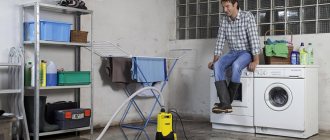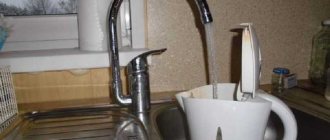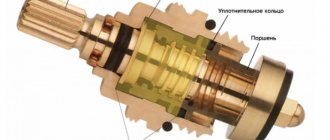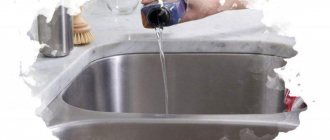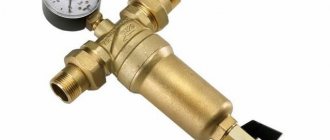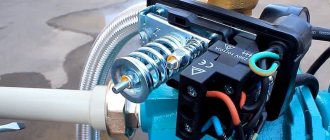Contactless type of service is often found in public places, restaurants and hotels; for a personal bathroom this type of water supply is used less often. A faucet with a motion sensor ensures water savings, careful use of the washbasin and speed of hand washing. The electronic device is a simple element from the Smart Home appliance system.
Features of touch taps
Everyone knows the type of standard faucet and its control elements - a pair of rotating knobs or a ball regulator. But at first glance, a touch faucet can cause bewilderment and misunderstanding of how to use it, because there is no usual flow control here.
A sensor faucet is an automatic water faucet without valves. All actions with it are carried out using photocells, IR, induction and ultrasonic sensors. They detect the presence of foreign objects (human hands) in the coverage area and turn the water on or off. Sensors can be included in the crane structure or supplied separately as a cover.
Each smart faucet has a sensitivity zone. Its parameters may vary, but on average it is about 25 centimeters.
The temperature is mainly regulated by levers or a rotary valve, but among expensive samples there are automatic ones with a touch strip. Some “smart” faucets are also equipped with a control panel, which can be used to regulate pressure and temperature from a distance.
Interesting: the hand sensors are made in such a way that they do not react to random objects entering the area of action. So, if you spill shampoo or knock over soap on the work surface, the automatic touchless faucet is not activated, since it must respond solely to the movement of human palms or the container being brought.
Peculiarities
The appearance of the touch tap raises an obsessive question - how to regulate the flow of water, turn the device on and off? Faced with this, future owners of this miracle of technology should know at least a minimum of information about the principle of operation of a touch-sensitive water tap.
The device is a monolithic faucet without any valves or other methods of regulating the flow of water. The action is carried out thanks to photocells and sensors of ultrasonic and infrared signals. They are the ones who detect the presence of foreign objects near the tap. All signal receiving components are installed in the crane itself. The signal is received in the so-called sensitivity zone, which is different for each device. Average sensitivity is approximately 25 cm. This means that the sensor will work when an object approaches it at a distance of 25 cm or closer. To regulate the water temperature, the touch faucet has special valves.
The device is powered by removable batteries, which last for approximately 2 years. After this, you can simply replace the battery and the faucet will work again. One battery lasts approximately four thousand starts.
A sensor faucet is a good water saver that will not let you forget about the water being turned on. He will turn it off himself when the owner moves away from the washbasin.
Where are they used?
Plumbing fixtures with touch controls can now increasingly be found in bathrooms/toilet rooms and kitchens of apartments, private homes and offices. In addition, water taps with an IR sensor for opening water and other varieties use:
- in many cafes and restaurants;
- in the areas of shopping centers and supermarkets;
- in hospitals and clinics;
- in cinemas;
- in other public places and spaces.
How to install correctly?
Installing a faucet equipped with an IR sensor is not particularly difficult. It consists of the following stages:
- It is necessary to shut off the water supply to the house.
- Remove the old faucet.
- Place the mounting gasket between the sink and the new device.
- The mixer is mounted on a gasket and secured with a nut.
- Using special fasteners that come with the kit, a control box is installed at the bottom of the sink. It is connected to the mixer using a flexible hose.
- The mixer is connected to the water supply using water pipes.
- Batteries are installed in the control box and power is connected.
- Using a nut, the sensor wire is connected to the corresponding connector.
- The functionality of the device is checked.
A faucet with an IR sensor is not famous for its riot of colors and variety of shapes, but choosing a device that will match your plumbing fixture is quite easy. With proper operation, this mixer significantly increases the level of comfort in any home. And even more so in public places.
Design and principles of operation
Let's look at the design of a touchless faucet using the example of a mixer with a built-in induction sensor. This element generates a magnetic field determined by the system settings and changes its value when human hands appear in the field of vision.
The functional part of the automatic mixer consists of:
- head control unit;
- the above-mentioned induction sensor;
- actuator unit - solenoid valve;
- check valve to prevent backflow.
The sensor creates a magnetic field determined by the device parameters. When an object enters the latter’s area, the sensor sends a command to the control unit. He, in turn, turns on the valve and opens the water. When the command stops (the signal is gone), the valve closes and stops flow.
The solenoid element consists of:
- actually, the solenoid coil;
- mixer membranes;
- gadget core tubes;
- shielding coil;
- saddles;
- seals;
- housings;
- structure retainer;
- tips;
- springs and core.
How does an automatic touchless faucet work:
- when a signal is supplied from the sensor, the magnetic field acts on the tap core;
- he rises;
- the membrane rises with it, and the water opens.
As you can see, the gadget needs electricity to work. Its supply is provided in two ways:
- from the home network;
- Autonomous, from batteries/accumulators.
There are various faucet models that support the first or second power supply (or both). The wall-powered sensor for the washbasin, kitchen or bathroom does not require battery replacement; you can simply install it, plug it in and forget it. But it is necessary to think about the installation location so that it is located near the source of electricity, or install another outlet nearby. A battery-powered automatic water mixer does not have this drawback; in addition, it is safer and works even when the lights in the house are turned off. But this is compensated by periodically replacing the batteries.
How the device works
The touch tap is driven by an induction sensor and a control unit. The sensor creates a magnetic field that detects any object entering its boundaries. When an object moves in the sensitivity zone, the control unit receives a signal about the need to supply water. When the magnetic field no longer detects movement, the power supply stops the water flow.
The water supply is carried out by a solenoid valve. When motion is detected, the magnetic field produces an electrical voltage that affects the solenoid valve core. During the lifting of the valve core and its membrane, water is supplied. If the batteries are discharged and the signals weaken, the water supply will stop.
Available in two types depending on the type of food. Some can be plugged directly into an outlet, while others require batteries. For safety reasons, it is better to use taps with batteries rather than those directly connected to the mains.
Principle of operation
Installation steps
Pros and cons of touch faucets
This category of touch-controlled devices has undeniable advantages over conventional mechanical ones:
- comfort and convenience. The tap is easier to operate, it does not have handles that can be screwed too tightly and then have to force to open;
- maintaining hygiene: if your hands are dirty, to start the water you just need to bring them to the sensor without touching the tap itself. This is especially important in public places visited by many people every day (restrooms in cafes, restaurants, restrooms), where plumbing fixtures tend to collect many microorganisms, including pathogens. A touchless faucet effectively solves this problem;
- An automatic touchless faucet saves water—and the owner’s money. If a person’s hands are not under the tap, water does not flow, which means the readings on the meter do not increase;
- you don’t have to worry about accidentally turning off the tap;
- Quite a few models support setting the desired temperature, so even young children can safely use such a smart mixer without fear of getting burned or hypothermic;
- As a rule, touchless faucets look very stylish and modernize the interior;
- some advanced models with automated water supply can be integrated into the “smart home” ecosystem. They can be given a command from a smartphone, for example, to fill a bathtub while in another room or even on the way to the house, and control the temperature and volume of liquid supplied in real time.
Of course, in the case of remote filling of the bath, you need to control the volume poured and know exactly how much it holds, or equip it with a water level sensor to avoid flooding.
But there are also disadvantages due to the specifics of the device:
- inconvenient to use if you need to change the temperature frequently. For example, this is not very comfortable in the kitchen, where you usually need either hot or cold water, and the automatic tap is configured only to support a certain mode. The settings will have to be constantly changed;
- The sensor faucet for the sink is also inconvenient in situations where large vessels and bathtubs are regularly filled. You will have to continuously keep your hands on the sensor; you cannot move away from the tap. This drawback is partially compensated for in models with sensor disabling (as well as overlays with this function);
- relatively high cost, which may make the mixer unaffordable for purchase. This situation is also partly corrected by much cheaper pads;
- dependence on home electricity or batteries. Without power, the touchless faucet is non-functional;
- If the faucet is equipped with a photocell sensor, there is a chance of false alarms due to glare of light. Infrared or ultrasonic options do not have this disadvantage.
Advantages and disadvantages of automatic faucets
Advantages
- Hygiene.
The main advantage of touch models is that you do not need to touch the faucet with your hands to supply water. This is especially important for public places with high foot traffic. - Saving.
According to average estimates, automatic faucets use 30% less water than manually controlled models. And, indeed, the mixer automatically turns off when not in use. - Compactness.
Touch faucets do not have levers or control valves, so the products can be of the most compact sizes. For example, the Oras Vienda model is only 12 cm high
Flaws
One of the main disadvantages of sensor mixers is the narrow focus of their application.
Such models are absolutely not suitable in cases where you use a shower, or you need to fill a bath or a pan in the kitchen, and in many other cases. Therefore, most manufacturers produce automatic models exclusively for sinks.
Types of automatic cranes
By purpose it is customary to distinguish:
- kitchen faucet/bathroom fixture with touchless sensor and U-shaped or swivel spout;
- built-in and external models for urinals;
- sensor faucet on the toilet. He starts serving with a delay of about 5 seconds and does it for 10-15 seconds.
Classification by control method:
- with push-button touch sensor. They are controlled via a touch panel, with its help you can use the faucet functions and change settings;
- contactless, not involving manipulation of the panel. On certain models you can set individual lighting themes and customize them in other ways.
Classification according to the length of the water jet:
- long - over 35 centimeters;
- with an average jet - 20–35 centimeters;
- shortened versions.
By mobility:
- fixed monolithic;
- with a rotating design.
It also highlights designer faucets made according to an individual plan.
Types of cranes according to operating principles:
- devices with separate taps;
- more complex single-lever options;
- with double spout;
- electronic.
Separate ones are the simplest. This device is a smart mixer with two separately adjustable taps from the hot/cold water supply. They have reliable electronic and mechanical components, are inexpensive and can be adjusted once to a comfortable temperature.
Among the single-lever types there are:
- ceramic type;
- spherical design.
The output flow is controlled by a single lever with a ceramic or ball cartridge built-in. Ceramics are more resistant to mechanical wear, but at the same time, they are sensitive to the composition of water. And the ball part wears out relatively quickly.
The design with a double spout is close to single-lever ones and is, in fact, their modification. The key difference is the presence of an integrated water filter in the system. Such mixers provide the ability to switch from direct water flow to a filter and back.
An electronic faucet with a sensor is the most complex. These models include many functions, for example:
- automatic control of water pressure and temperature;
- setting memory operation modes for several sets of parameters;
- remote access, and so on.
They also include a remote control point. The gadgets are aesthetically pleasing and fit well into interiors.
The disadvantage of such models is their high cost and difficulty in repairing; it is difficult to repair such a mixer in the event of a malfunction. Therefore, they are still not very popular in Russia.
There is also a division according to the work program:
- non-contact mixer with continuous flow. This plumbing supplies water to a person from the moment movement is detected by the sensor until it stops;
- automatic touch with periodic spout. These faucets detect movement, turn on the flow for a set number of seconds, and shut off.
Classification by sensor type was discussed at the beginning of the review. Mixers with an infrared sensor and ultrasonic ones are more reliable, since the photocell, as already mentioned, has a chance of false positives when light reflections fall on the working surface.
There is also a separate subtype of smart faucets - attachments for standard mechanical ones.
Touch attachments
As the name suggests, these devices are mounted on a simple water tap.
Their operating principle is simple:
- the nozzle is installed;
- water opens;
- Until the infrared (or other) sensor is triggered, the device is in standby mode and acts as a passive plug, opening the water only when the sensor is activated.
These gadgets fit almost any home faucet, run on batteries and allow you to turn even an old Soviet faucet into an automated one. There are options with different functionality - adjusting the response delay, jet output time, and so on. The disadvantage of this solution is that the temperature and pressure still have to be adjusted manually.
Manufacturers claim long battery life. For example, attachments from the Xiaomi product line can work for up to six months without recharging. They usually have an infrared or induction sensor.
Design
According to their design features, all faucets with an infrared water supply sensor can be divided into:
- Optoelectronic with IR sensor : they have a photocell that reacts to movement within a certain area. If desired, you can increase or decrease the sensitivity of the device, which will make it possible to adapt it to your needs. In this case, the sensor is located at the bottom of the spout. It is triggered when hands are brought to it . You can also set a time delay: how long the water will flow after stopping movement in the area of the sensing element. Such products are expensive and are rarely used in everyday life.
- Automatic with IR sensor : durable, reliable, easy to operate and maintain. They work by creating an induction field by the sensor. When a moving object enters the perimeter of its action , the field parameters change , a signal is sent to the control unit, and a valve is activated, supplying or, on the contrary, shutting off water.
The infrared sensor is the main element of this design.
It is located in the working panel of the device, directly under the mixer. The touch tap operates using a lithium battery that supplies and shuts off liquid. Most faucets with a touch sensor are designed the same way. Kit includes:
- electronic unit for controlling the device;
- connecting fittings (hoses);
- fine or coarse filter;
- a lever, as well as a valve that allows you to adjust the desired temperature range.
These faucets do not have handles or taps . Only one button is used to control the device. Some models equipped with an infrared sensor have a sensitive zone that can be adjusted. It is up to 300 mm. This distance is the most optimal; you should not change it.
In addition, there are manufacturers that supply plumbing fixtures with remote controls . You can easily do without such an element, so it all depends on the personal preferences of the apartment owner.
An instant water heating faucet is a device that serves as an alternative to central hot water supply and storage water heaters and boilers. Read how to choose and install a water filter in this publication.
Step-by-step and detailed instructions for installing cold and hot water meters with your own hands can be found here.
How to choose a touch faucet
To choose the right “smart” plumbing, you need to focus on the following points:
- It is advisable to choose models with a sensitivity adjustment function. This will allow you to flexibly configure the tap according to the owner’s preferences;
- It is better that the purchased mixer with a sensor has additional functions - turning off the flow by timeout, frequency of turning on and off, etc. The more of them, the more convenient it will be to use the device (but it will also cost more);
- presence of temperature control;
- if you plan to create a “smart home” complex, a device with a motion sensor must be able to be integrated into a home automation system.
You should also consider:
- body material;
- presence/absence of a remote control or control via an application;
- jet length;
- mixer dimensions;
- a set of additional functions;
- type of power supply - from an outlet or autonomous. This parameter is critically important, since it largely determines the installation location;
- type of sensor (faucet with an infrared sensor, ultrasonic model, or another).
When choosing a faucet, you should pay attention to its system - one- or two-pipe. If you plan to supply both hot and cold water, the choice should be made on a two-pipe scheme. We must not forget about the aesthetic side of the issue: for example, in a room with another faucet already installed, it is advisable to choose an automatic one that matches it in style.
Popular brands
When choosing the model you like, pay attention to the reviews of the manufacturer. The following brands have proven themselves well on the market:
Kopfgescheit - Austrian faucets with infrared sensors made of bronze with the ability to configure the sensor response zone and turn it off using the remote control. The operating temperature of the mixer is 1 - 45 ° C, the response time delay is 0.5 s, the sensor coverage area is 25 cm (factory settings), the operating pressure is from 0.5 to 7 bar. The warranty period for Kopfgescheit (Smart Head) products is 5 years.
Lemark are Russian-made Czech brand faucets, made of stainless steel and brass, equipped with ceramic shut-off cartridges, capable of withstanding pressure up to 9 atmospheres. The high quality of the product is indicated by the warranty period of 4 years from the date of purchase.
Frap is a Russian brand of sanitary ware manufactured in China, characterized by an optimal price-quality ratio, as evidenced by two main product lines - Standard and Lux. The product is produced using Italian technology, as a result of which the outer surface of the taps is perfectly smooth. There are faucets available in the market in a variety of colors.
Frap touch models contain shutdown timers and electronic thermostats; their standard operating temperature threshold is 38 °C. For budget faucets, the warranty period for cartridges and locking elements is 1 year, and the body is guaranteed for 5 years.
Gappo - Chinese faucets produced using German technology have been known on the Russian market since 2002. The brand belongs to the largest manufacturer of sanitary equipment - the Haiba concern. The products are distinguished by perfectly smooth ceramic cartridges and a special design of aerators that make the flow light and airy, and the use of high-quality Spanish Hens and Sedal cartridges significantly increases the service life of the equipment. Budget faucets are produced in a wide range of stylistic solutions, various shapes, colors and models, the warranty period established by the manufacturer is 5 years.
Rice. 10 Cost of brands Grohe, Gappo
Grohe - products from the world famous German company are sold in more than 130 countries. Its distinctive features are German quality and, accordingly, a service life of up to 30 years, stylish design, technical excellence using cutting-edge technologies. The mixers are easy and reliable to install, convenient to use, and Grohe products have a warranty period of 5 years. Like all European plumbing fixtures, Grohe taps cannot be classified as budget products; their cost compared to analogues is much higher, which is compensated by the above advantages.
Among German companies supplying their plumbing products to the domestic market, brands such as Himark, Hansgrohe, Axor, Kludi, Blanco are less well known.
Oras is a brand of the Oras Group from Finland, whose history began in 1945. Its subsidiary is the German company Hansa; in addition to Finland, factories are located in the Czech Republic, Poland and Germany. Oras touchless faucets are equipped with a unique development of the company - a highly sensitive Oras Autofocus sensor.
Oras faucets are made from chrome-plated brass alloy by seamless casting, can withstand high pressure loads, and their flexible hoses feature a left-hand thread. When aerating, air bubbles are added to the water, which makes the flow smoother and reduces water consumption. Unlike its European counterparts, the cost of Oras is more affordable; all products have a warranty period of 5 years.
Rice. 11 Price and appearance of mixers Oras, Ksitex, VitrA, Varion Armaturen
Ksitex is a domestic manufacturer of various equipment and technology for toilets and bathrooms. It produces about a dozen contactless models of automatic faucets costing from 6,000 to 9,000 rubles. The devices can withstand pressure up to 7 atmospheres, operate in a temperature range from 1 to 60 °C with a water flow of about 10 liters per minute. The factory setting of the sensor at 16 cm can be changed automatically; depending on the model, the solenoid valve is located outside in a separate block or inside the device body.
VitrA is a Turkish brand owned by a company that is part of Turkey's largest holding company Eczacibasia. There are about 40 more companies under his patronage. The holding's enterprises, with an annual turnover of $3.2 billion, employ over 10,000 employees. Eczacibasia owns German companies: Engers (manufacturer of ceramic tiles) and Burgbad, a European leader in the production of furniture for sanitary facilities and bathrooms.
The VitrA line of touchless faucets is called AquaSee, the taps are connected to cold and hot water with two connections, the solenoid valve is located inside chrome-plated brass bodies. The VitrA line of touchless faucets has few models, and you can’t call them budget ones either - the cost of a regular faucet with an infrared sensor is about 17,000 rubles.
Varion Armaturen - despite the formidable German name, faucets under this brand are produced by a production and trading association from St. Petersburg. In collaboration with the Finnish company Variosan OY, the company has developed and produced advanced plumbing fixtures using components from their world-famous companies: DiLorenzo (Italy), Fluhs (Germany), Valfsel (Turkey), Neoperl (Germany), Aere Plast (Italy), Vernet (France), KCG (Taiwan). The range of Varion sensor mixers is not too wide; the average cost of a typical model is about 11,000 rubles.
Rice. 12 Basic operations when installing a tap with internal mixing
Faucet installation
Let's consider the main stages of the device installation process.
Installation of a sensor mixer takes place in two main stages:
- placement of the gadget body, control unit;
- connecting it to water pipes.
Important: before starting work, be sure to turn off the water supply!
The first step is to dismantle the mixer to be replaced, if there is one. As a rule, installation is carried out in the designated mounting hole in the sink. A special gasket is placed between it and the “smart” plumbing fixture, usually included in the delivery kit. If you don't have it, you need to buy this consumable.
The bottom of the tap is placed on a gasket with plates and secured with the supplied nut. All fasteners are usually included in the box. Next, the mixer control box is installed.
Important: there must be at least 55 cm from the box to the floor! The touchless faucet is connected to the box with a flexible hose.
Next, you need to supply water to the device. For this purpose, the nipples are connected to the water pipes, and a gasket is placed at the junction of the control box and the smart faucet.
The key element of a plumbing gadget is the solenoid valve. For its correct operation, the solenoid is connected to the control unit via a wire (to do this, it is usually necessary to remove the bolted housing cover). Batteries are also installed there (if the device is autonomous).
When everything is connected and the batteries, if any, are placed, you can assemble the unit, turn on the water and check the faucet for functionality. The principle of installing bath/shower taps is generally similar, with the exception of the features of wall mounting.
Where can a sensor attachment on a faucet be used to save water?
Area of application: on the tap in the bathroom or kitchen. At the same time, their functional features and structure differ. If an inexpensive type of mechanical action can be used for the bathroom, then for the kitchen it is worth choosing more expensive but effective options with electronic or even remote control.
Faucet repair
In simple cases, minor independent repairs or diagnostics are possible. Let's look at some common situations:
- There is no water shutoff. With such a malfunction, most likely the membrane is clogged. The mixer should be disassembled and the membrane should be cleaned of scale and dirt particles.
- Failures, false positives. These symptoms indicate a sensor malfunction; it needs to be checked and, if possible, replaced.
- Accidental operation of a faucet powered by photocells. Most likely, this situation is due to glare from light sources. The light flux can be reflected from the sink and affect the sensor. The solution is to remove the disturbing excess lighting.
Interestingly, in rare cases, the infrared sensor also detects visible light.
Adviсe
- To set individual settings, choose models with sensitivity adjustment.
- The presence of additional functions affects the cost of the mixer. However, they are not always used.
Other factors responsible for pricing are jet length, material, size, devices, manufacturer.
- Give preference to models with the ability to adjust the water temperature.
- When choosing, consider the tap system. Types: single-pipe and double-pipe.
- The mixer must be made of durable materials and meet sanitary and hygienic standards.
Touch faucets are the best solution for installation in public places to solve the issue of hygiene, because you don’t have to touch them. But in recent years they have also been used at home due to the undeniable advantages of the products. The models are presented in a wide variety, which allows you to choose the appropriate option. Installation does not require special knowledge, and repairs are carried out by removing scale particles or replacing the sensor. It’s just that you have to spend money on such devices, but the investment will pay off quite quickly.
Is it worth buying a sensor faucet?
Plumbing fixtures from this family help solve many problems:
- Ease of use;
- safety of family members and home;
- automation of daily actions;
- remote monitoring and control;
- combating unsanitary conditions in public premises, protecting them from leaks.
The “smart faucet” will be relevant for all lovers of new products and just people who want to equip their home/commercial premises with the latest technology. It's comfortable, stylish and practical. But you should take into account the nuances of use - for example, where you often need to adjust the water temperature and switch between cold and hot, a touch tap may become inconvenient. It will also not be suitable in cases where you need to draw a lot of water - after all, something must “keep” the sensor in action for this time, which means you will have to constantly keep your hands nearby. But this problem can be solved by purchasing a flexibly configurable model with the ability to temporarily turn off.
It is important to clearly define the location of the tap (kitchen, bathroom) and its tasks. The choice of device model and type depends on this. A bathtub faucet is not suitable for a kitchen, and vice versa, and in brightly lit areas it is better to provide an infrared option.
If you don’t want to spend time and effort installing a full-fledged mixer, it makes sense to pay attention to sensor attachments. This will cost much less and allow you to enjoy almost all the benefits of touch control of water.
Installation
The sensor faucet for the sink can be installed as a regular mixer, with cold and hot water supplied to its body, or as a device made up of separate units. In the latter version, the magnetic valve is located in a separate mixing unit under the sink, and water is supplied to the faucet body through a single hose.
When purchasing any model, the installation procedure is indicated in the instruction manual; to connect a standard modification with two supply hoses and a mounting pin, proceed as follows (Fig. 13):
- Screw two flexible hoses to the mixer body from below. Unscrew the nut from the stud and remove the plastic ring, leaving the rubber gasket in place, and insert the mixer into the hole in the sink.
- Place the plastic ring on the stud and tighten the fastening nut using a socket wrench.
- Screw the flexible hose to the branch pipes of the water pipes, having previously installed coarse water filters on them.
- Use a hammer drill to make a hole in the wall under the sink, drive in a dowel and screw in a screw. Insert four AA batteries into the power compartment box, hang the unit on the screw and connect the cable to the cord coming from the mixer.
- The same is done with an electrical power supply that converts an alternating voltage of 220 V into 6 or 9 V - it is hung on a screw and the plug is plugged into a socket.
- Further adjustment of the sensors is carried out in accordance with the instructions - usually the hands are held at the desired distance, waiting for automatic fixation and memorization of the position for several tens of seconds.
Rice. 13 Installation of a touchless mixer
Faucets with contactless control are the technology of the future; modern high-tech devices with a remote control can greatly facilitate the comfort and hygiene of their use. An obstacle to widespread use in everyday life is the rather high cost and impracticality of some models for use in the bathroom and kitchen. Contactless devices have undeniable advantages over traditional taps in public sanitary facilities, ensuring hygiene and significant savings in water resources.
What other water-saving nozzles are there to save water?
The list of nozzles that allow you to save water is not so extensive. In addition to the sensor block, there are developers who spray, make a stream in the form of a lattice and do not allow pressure to flow into the sewer unnecessarily. The essence of such a device is the dissection of one integral jet into several slats, which maintain pressure but reduce the amount of water used.
In combination with the color accessories, the diffuser in the form of a lattice base turns simple hand washing into a show.
Operating principle, main advantages
The main purpose and purpose of sensor attachments on a faucet's jib is to provide water at the time it is needed. Therefore, in addition to saving water and money, the installed device allows you to feel comfortable under any circumstances. There is no need to worry about the faucet getting dirty when the housewife is cooking in the kitchen; washing your hands will be easy - just bring them under the tap, and the device will independently recognize the object and control the water supply.
The device externally looks like a monolithic block, a nozzle without valves or holes. The principle of operation is to ensure the supply of water by recognizing photocells and sensors of ultrasonic and/or infrared signals. Sensors that receive signals are installed directly in the faucet, and the recognition process occurs in the so-called “sensitivity zone” - a magnetic field.
The solenoid valve helps to recognize objects entering the magnetic field zone, it consists of:
- solenoid and shielding coils;
- membranes and core tubes;
- housings;
- springs;
- clamps and tips;
- seals.
The radius of the sensitive zone is determined by the quality of the photocells or infrared sensors used: the higher the quality, the greater the response radius. 25-30 cm is an average figure, however, it can be increased or decreased on the electronic control unit. There are special valves to regulate the temperature.
Touch faucet kit:
- Control block;
- batteries or wire for connecting to the network;
- spout (gander);
- valve;
- lever regulating controls;
- connection hose;
- filter.
Operation is ensured by internal batteries. On average, one battery lasts for 4 thousand on/off times. There are models connected to the network.
Advantages:
- Practical and hygienic - there is no need to dirty the faucet by touching it with dirty hands.
- An economical device for reducing water bills.
- Becomes an integral element of design and practicality.
- By adjusting the temperature of the supplied water there is no risk of burning your hands.
The disadvantages include the extremely high cost of relatively simple diffusers for the gander tip.
Kinds
The types of such attachments differ depending on the intended purpose.
- By design purpose: kitchen rotary type, built-in or external (for example, for urinals), for toilets.
- Differences in appearance: external, built-in, with or without a regulation sensor.
- Interior design: with or without backlight, smooth, straight or round, colored or metal.
- By type of water supply: sensitivity zone, supply time, shutdown timer, adjustment of water temperature and its pressure, volume.
Buying a sensor attachment is much cheaper than purchasing a touch faucet, and such a device is much easier to maintain.
Operating modes
The sensor attachment operates in two modes:
- Manual. It starts working only when you need to pour water into the pan. It differs from the second one in the speed of water supply. For example, if a small amount of water is enough to wash your hands, then you don’t want to wait several minutes to fill the pan.
- Auto. It works if hands appear under the tap. The amount of water in this case is insignificant, but the pressure is just as high due to the diffuser of the water jet.
Switching mode - using a button on the front of the nozzle. To switch to the first mode, open the tap, determine the required water pressure, and press the activation button. To turn it off, you first need to switch it to manual mode by pressing the switch button once. After this, turn off the water taps.
There are separate models of nozzles that protect themselves from irrational use. When the nozzle is switched to manual mode, the water flow is automatically stopped. In this case, the green diode on the device lights up for exactly a minute.
Cheaper models have only one operating mode with one operating radius. Switching to separate modes or adjusting the pressure will not work.
Shutdown
The shutdown mode also depends on the manufacturer and settings.
For example, there are modifications of the device where the shutdown occurs within 2-3 seconds after the hand disappears from the sensitivity zone. But there are other options when shutdown occurs after some time, despite the presence of an object in the response zone. The last option is convenient if the housewife forgot to remove the pan from the sink and left. In this case, the water will flow continuously. With the time mode settings, stopping after the required time, according to previously set parameters, there will be no risk of flooding. To resume the flow, you just need to stir the pan.
Additional functions
Expensive models not only have options for controlling water supply when hands are in range, but also additional functions that simplify everyday life.
- Light illumination – colored or neon. When you turn on the tap, you will not need to turn on additional lights in the kitchen or bathroom. This is convenient especially in the evening or at night. Neon lighting looks attractive and extraordinary. There are also options to change colors like a rainbow.
- Temperature regulation. If there are children in the house or a double-circuit water heater is installed, then the water can be of different temperatures, up to boiling water (if the water heater is constantly turned on). In this case, there is a special settings option where the maximum permissible temperature is set.
- Pressure. Models that regulate water supply pressure are simply irreplaceable in homes where there is initially low pressure or frequent changes. In this case, there is a special option to control the pressure inside the tap.
All of these additional options increase the cost of products, in some cases such a markup is 60-70%.
